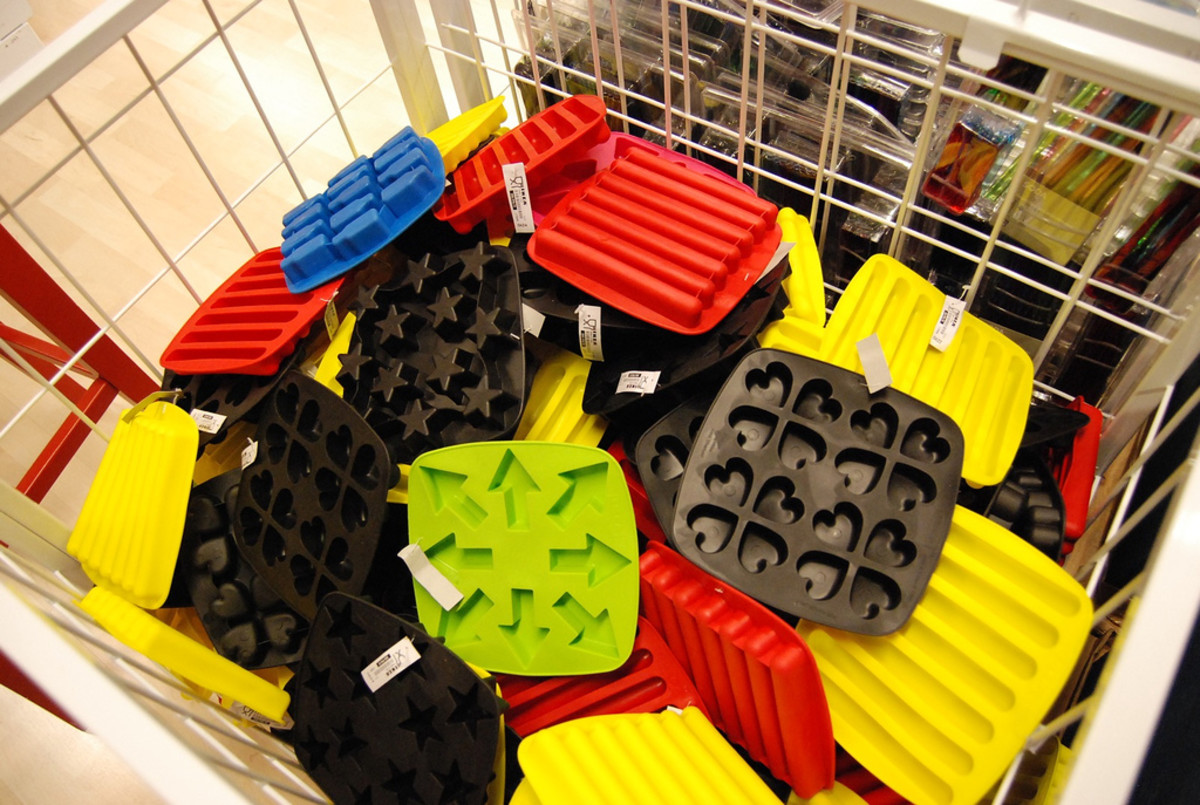Team Building Games
Ice Cube Relays
Divide your participants into two groups. Each of these teams in turn breaks up into two groups, one at one end of the room, the other at the opposite end. Give each of these four groups a knife. Place two ice cubes on a tray.
At the signal "Go" the first two participants must each try to slide an ice cube onto his knife, carry it across the room and place it on the knife of the next participant, who then carries it back and gives it to the one waiting at the other side.
This continues until one of the sides has passed the ice cube from participant to participant and becomes the first one to successfully carry out the relay. If an ice cube drops, the player is not disqualified, but must stoop down and scoop it back on his knife without using his other hand.

Soap Bubble Race
About three teams, with three on a team, are sufficient for this game. One team member in each group is given a soap-bubble blower with an ample supply of soapy water. The other two members of each team are given fans.
At the signal "Go," each soap blower from each team blows a bubble. The other two team members then proceed to try to fan that bubble across the room. The soap blower follows behind them. If any team's soap bubble breaks before it can be fanned across the goal line, then the soap bubble blower blows another bubble at the point where the last one broke.
The first team to get a soap bubble across the goal line is the victor. Use a committee of judges to see to it that everything proceeds according to Hoyle.
Necktie Relay
Divide your male participants into two or more teams. Instruct each participant to take off his coat, vest and necktie. The first member of each team is given a cheap or battered necktie and at the signal "Go," must put on the necktie, then take it off and hand it to the next one in line. This continues until each participant has put on the necktie, removed it and passed it on down the line. The first team through is the winner.
Assign an impartial judge to make sure that each participant properly dons his tie before removing it. Do not insist on anything fancy, just be sure the tie is correctly knotted and drawn into place.
Parlor Archery
A needle, with a short piece of thread attached to it, makes an excellent throwing dart. Beforehand, test a half dozen needles getting the right size thread in each. Then put some kind of a cloth target on the wall, and let your participants in tum try their skill.
If played by teams, use colored thread to identify the throws and points earned of each team.
Eskimo Relay
This is good for lots of laughs and an equal supply of excitement. You may use two teams or more, but it is best to have five or six on each team.
Place each team in line with the players standing behind each other about three feet apart. Give the first one in each line a large ice cube. At the signal "Go," each leader turns and places the ice cube on the neck of the one behind him, who must stoop over. That one tries to balance the ice cube as long as he can. As soon as it slips he must either catch it or pick it up from the floor, then tum immediately and place it on the neck of the next person. This continues until the ice cube has gone all the way to the end of the line, and has been placed on the neck of the one who started the procedure, who slipped to the back as soon as the race started.
All of the others remain in their positions.
The winning team is not the one which gets the ice cube to the end of the line first, but the one which is able to take the longest time to get the ice cube to the end of the line! Have a committee of judges on hand to see to it that no one dawdles along the way. As soon as an ice cube is dropped, it must be immediately picked up and placed on the neck of the next person. The only delay of time can come about when one is able to keep the ice cube from slipping off his neck.
The use of hands is strictly forbidden except in moving the ice cube from one person to another. Make the ice cubes of sufficient size so that there will be no danger of their melting before they cover their course.
A variation of this game is to place the ice cube on the top of the hand, with each participant holding it there as long as possible. Individuals or teams can compete.
Peas on the Knife
Place two bowls of peas at one end of the room and two empty bowls at the opposite end. Have an equal amount of peas in each bowl. Select two teams and give the first one in each line a knife. They run to the bowl and scoop up as many peas on the knife as they can, bring them back and dump them into the empty bowl at the point from which they started. They then give the knives to the next participants in line, who repeat the procedure.
The team which first transfers its peas from the one bowl to the other is the winner. Any peas which fall along the way must also be picked up on the knife and brought to the bowl. These peas can be left until the very last, if desired. All peas must be retrieved, though, before a victor can be named. Because of the nature of this relay some team members may have more than one tum. Keep a sharp eye open so that experts aren't pushed ahead of blunderers the second time around.
Spoon and Bean Relay
Divide your participants into two or more teams. Half of each team stands at one end of the room, the other half at the other. Each team member is given a spoon which he holds in his mouth. The first participant of each team places two beans in his spoon and at the signal "Go," hurries across the room to the waiting participant at the other goal.
Holding his hands behind his back, the participant with the beans must put the beans from his spoon into the spoon of the other. If a bean drops he must pick it up and put it back into his spoon, and attempt again to put it into the spoon of the other. As soon as the two beans have been put into the other spoon, that participant hurries back across to the other side and does the same. If a bean drops out of the spoon while a player is going from one goal to the other he must stop and replace it.
Instead of a relay, participants on each team can also stand in a line and pass the beans from spoon to spoon.
Shoes in the Target
Divide your participants into two or more teams. Place a basket or large box a distance of ten or fifteen feet from the starting point. Each participant of each team is given a chance to kick each of his shoes into the basket. At the close of the game count up the shoes and see which team netted the most points.
Cracker Eating Relay
Select two teams or more. Give each participant a cracker.
At the signal "Go," the first member of each team begins to eat his cracker. He may eat as fast as he wishes. The idea is that the second person in line may not begin to eat his cracker until the first one has been able to whistle. This goes right on down the line, until one of the last members of one of the teams is the first one to whistle, thus bringing his team in as champion.
It Is in the Balloons
Divide your participants into two teams or more. Each member of each team gets a balloon. Ahead of time write out a series of instructions, giving the same instructions in each set of balloons. At the signal "Go," the participants begin blowing their balloons. They must blow until the balloon bursts so that they can get the instructions which are on a piece of paper inside the balloon.
The idea is that all the participants in each team must break their balloons so that they can put their instructions together, then follow them out. Have the instructions guide the teams as to where they must go and what they must do, and the first one through wins.
Balloon Relay
This is a shuttle relay in which you have two or more teams, each with an even number of participants. Half the participants stand on one goal line, the other half on the other. Give each team a balloon of uniform size. At the signal "Go," the first participant in each team begins to run, batting the balloon in the air along with him. He cannot catch the balloon, but must keep tapping it with his hands.
The object is for him to bat the balloon down to his waiting teammate at the other goal, who then takes the balloon and bats it back to the other goal, repeating the procedure.
Balloon Burst Relay
Divide your participants into two or more teams, each with an equal number of participants. Each participant is given a balloon. At the signal "Go," the first participant on each team begins blowing his balloon. As soon as his balloon bursts the next participant may begin blowing.
This continues until one of the teams has been the first one to burst all of its balloons, and is thereby declared the winner.
A variation of this might be to give each participant a stick of bubble gum, making sure that each participant knows how to blow bubble gum, and then have the first participant put the gum in his mouth, chew it and blow a bubble which bursts. As soon as the bubble has been blown and bursts the second participant may put his gum into his mouth, chew it and do the same. This continues on down the line.
Keepaway
This is an old favorite in which two teams try to keep a ball from each other. A volleyball or basketball is preferred.
Blindfold Leapfrog
Add new spice to the old childhood game of leapfrog.
Divide your participants into teams of an equal number and blindfold each participant. First team through is the winner and you will, of course, keep strict rules insisting that every frog must leap over everyone in front of him, no matter how much fumbling it takes him to find his way if he should get off course.
Tug o' War
You need a good strong rope, at least a hundred feet long. Choose two teams and place one group at one end of the rope, the other at the opposite end. Each participant gets a good grasp on the rope. Tie a white handkerchief at the very middle of the rope.
Each group pulls in its own direction as hard as possible, and tries to pull the other team completely over to its side. The object of the white handkerchief is to give an idea as to which team is gaining the decision.
To add a bit more incentive to this game, fill a box full of candy bars or some other prize and place this exactly in the center. As soon as one team is able to pull the other team beyond the box the box and its contents becomes their property.
Pop the Bag
Divide your participants into two or more teams. Line up all the teams at the beginning line. Opposite from the beginning line, about fifty yards away, place as many empty paper sacks as there are members of each team. At the word "Go," the first member of each team runs and picks up a paper sack. He blows it up and pops it, then turns and runs back and touches the next person in line, who runs and does the same.
Scavenger Hunt
Divide your group into two teams or more with perhaps six or eight on each team. You can have as many teams as you wish. Give each captain an identical list of objects which must be found by each team. Then send them on their way. The team which comes back with all of the objects first, or the one which gets the most during the time limit which you set, is the winner. Have the group try to get such objects as: an acorn, moss from a tree, a four leaf clover, a needle from a pine tree, a crooked rusty nail and the like.
Apron Relay
Divide your participants into two teams or more, dividing each team into two groups, one at one end of the running area, the other at the opposite end.
Hand an apron, preferably the kind that goes over the neck and is tied behind the back, to the first participant of each team. At the signal "Go," each participant must put on his apron. Judges watch so that no one begins to run until the apron is on and tied.
The participant then runs to the other member of his team across the running area. T here he stops, takes off his apron, gives it to his teammate, who proceeds to put it on and then runs across to the next teammate.
Pop Bottle Relay
Select two or more teams with an equal number of participants in each team. Each team lines up at the starting line and at the signal "Go," the first member of the team runs to the opposite goal line. There he will pick up a pop bottle, take an opener which is provided, open the pop bottle and drink it. As soon as he has finished drinking the pop he may run back and touch the hand of the next member of his team. who runs to the goal line and does likewise.
If you want to economize use lemonade or some other cheaper nectar instead of pop. Then, since you probably will not be able to have the drink placed in bottles, use cups and have the participants sip the contents through straws.
Candle Relay
Divide your participants into two or more teams. Half of each team stands on one goal line, the other half on the other.
At each goal line is a candle which is kept stationary, to be used in lighting candles which go out. At the signal "Go," the first participant in each team lights his candle and then hurries across the racing area to his waiting teammate on the other side. If the candle goes out while he is running he must return and light it again. If he succeeds in getting across, keeping the candle lighted, he hands it to his teammate who endeavors to hurry across, without letting the candle go out, to the next teammate at the other goal.
This continues until each participant has crossed the racing area, and one team is the victor.
This content is accurate and true to the best of the author’s knowledge and is not meant to substitute for formal and individualized advice from a qualified professional.
© 2012 Longtail








